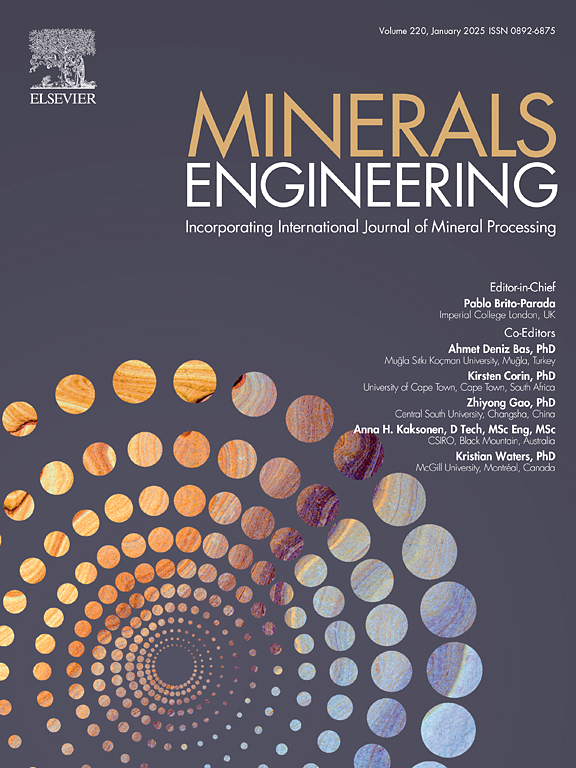生态友好型槐脂使钛辉矿与钛辉矿的浮选分离具有选择性和高效率
IF 4.9
2区 工程技术
Q1 ENGINEERING, CHEMICAL
引用次数: 0
摘要
钛铁矿和钛辉矿具有相似的表面化学性质,它们的选择性分离面临挑战,因为传统的脂肪酸基捕收剂存在一些缺点。在这项工作中,生物基皂荚脂被评估为一种生态友好的捕收剂,用于选择性分离钛铁矿和钛辉矿。结果表明,槐脂比油酸钠能更快、更有效地回收钛铁矿。结果表明,钛铁矿浮选的理想pH范围为6 ~ 8,当槐脂用量为1 × 10-4 mol/L时,钛铁矿浮选回收率最高可达95%。槐脂的临界胶束浓度(1.6 × 10-4 mol/L)比油酸钠的临界胶束浓度(1 × 10-3 mol/L)约低一个数量级,表明槐脂需要较低的浓度才能实现有效的表面覆盖并形成疏水钛矿表面。此外,原子力显微镜观察显示,与油酸钠相比,槐脂作为捕收剂时,疏水钛铁矿界面更厚,从而支持更好的钛铁矿可浮性。x射线光电子能谱、zeta电位、傅里叶变换红外光谱和拉曼测量结果表明,带负电荷的槐脂类吸附在钛铁矿表面,改变了钛铁矿的电动力学性质。钛铁矿表面的铁和钛都是槐脂化学吸附的键合位点。此外,在pH = 6时,槐脂类吸附的标准自由能最低,导致槐脂类在钛铁矿表面的吸附增加。本文章由计算机程序翻译,如有差异,请以英文原文为准。
Eco-friendly sophorolipid enabling the selective and efficient flotation separation of ilmenite from titanaugite
Ilmenite and titanaugite share similar surface chemistry and their selective separation presents challenges as conventional fatty acid-based collectors have several drawbacks. In this work, bio-based sophorolipid was assessed as an eco-friendly collector for selectively separating ilmenite from titanaugite. The results indicated sophorolipid can realize a faster and more efficient recovery of ilmenite than sodium oleate. The ideal pH range for ilmenite flotation was found to be between 6 and 8, with a maximum recovery of ∼95 % achieved at a sophorolipid dosage of 1 × 10-4 mol/L. The critical micelle concentration of sophorolipid (1.6 × 10-4 mol/L) was approximately one order of magnitude lower than that of sodium oleate (1 × 10-3 mol/L), indicating that sophorolipid required a lower concentration to achieve effective surface coverage and create a hydrophobic ilmenite surface. Additionally, atomic force microscope observations revealed much thicker hydrophobic ilmenite interface when using sophorolipid as the collector, compared to sodium oleate, thus supporting a better ilmenite floatability. X-ray photoelectron spectroscopy, zeta potential, Fourier transform infrared spectroscopy and Raman measurements revealed that the negatively charged sophorolipid species adsorbed onto ilmenite surface and altered its electrokinetic property. Both iron and titanium present on the ilmenite surface acted as bonding sites for sophorolipid chemical adsorption. Moreover, the standard free energy for sophorolipid adsorption was the lowest at pH = 6, leading to increased adsorption of sophorolipid species onto ilmenite surface.
求助全文
通过发布文献求助,成功后即可免费获取论文全文。
去求助
来源期刊

Minerals Engineering
工程技术-工程:化工
CiteScore
8.70
自引率
18.80%
发文量
519
审稿时长
81 days
期刊介绍:
The purpose of the journal is to provide for the rapid publication of topical papers featuring the latest developments in the allied fields of mineral processing and extractive metallurgy. Its wide ranging coverage of research and practical (operating) topics includes physical separation methods, such as comminution, flotation concentration and dewatering, chemical methods such as bio-, hydro-, and electro-metallurgy, analytical techniques, process control, simulation and instrumentation, and mineralogical aspects of processing. Environmental issues, particularly those pertaining to sustainable development, will also be strongly covered.
 求助内容:
求助内容: 应助结果提醒方式:
应助结果提醒方式:


